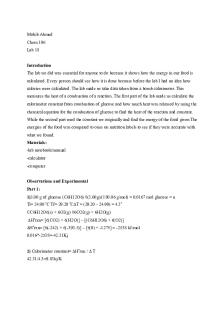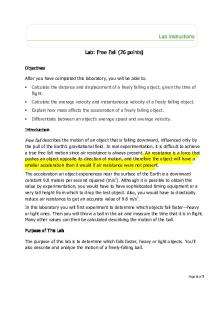Lab 1 Isolines Fall 18 proced PDF

| Title | Lab 1 Isolines Fall 18 proced |
|---|---|
| Course | Weather And Climate |
| Institution | Binghamton University |
| Pages | 4 |
| File Size | 328.3 KB |
| File Type | |
| Total Downloads | 23 |
| Total Views | 142 |
Summary
This is the first Lab of GEO 120....
Description
Binghamton University Geography 120 Weather and Climate
Professor Bruce Oldfield
ISOLINES ON MAPS Learning Objectives: 1. Learn how to determine latitude and longitude on a map. 2. To interpret isolines, determine what they represent, and how they are used. 3. To locate points, measure distances, and use scales on maps. 4. To read and interpret isoline. Introduction: We are using topographic and weather maps as a way to introduce the concept of isolines. In weather and climate, we use several isolines including isotherms (equal values of temperature) and isobar (equal values of atmospheric pressure). Isolines are used in meteorology as visual ways of understanding large data sets of weather and climate not only conditions on the Earth’s surface but also conditions aloft, in the vertical sense. Part A Topographic maps are especially useful to everyone because they portray the shape of the land surface through the use of the brown contour lines. Contour lines (a type of isoline) connect points on the ground surface having equal elevations above sea level. Since it usually impossible to label every single contour line with its elevation, every fifth line, called the index contour is darkened and most of those are labeled with their elevations in feet above sea level. The contour interval is the change in the altitude between two adjacent contour lines. Common contour intervals, in feet are 10, 20, 25, 40, 80, 100, and 200. Latitude: Latitude tells you your angular distance north or south of the Equator (0° latitude). By definition, the Equator is 90° from the Earth’s axis of rotation. Latitude lines are represented by the upper case Greek letter (Φ, Phi)) in the diagram below. Latitudes are also called ‘parallels’ as all latitudes are parallel to the Equator. Latitude lines run east – west (right – left) across most maps, yet measure the angular degree above and below the equator. Latitude lines can be specified in degrees, minutes, seconds all along its length, so that the west end of the line must be labeled the same as the east end. There are a number of latitude lines that are universally used such as the Equator, Tropic of Cancer (23.5 degrees north latitude), Tropic of Capricorn (23.5 degrees south latitude) and the north and south geographic poles. Longitude: Longitude is the angular distance east or west of the Prime Meridian (0° longitude), which runs from the North Pole to the South Pole through a screw on a telescope at Greenwich, England. We started using the Royal Naval Observatory telescope as the Prime Meridian of longitudes in 1884. Longitude is represent by λ (lower case Greek letter, lamba) in the diagram below. Longitude is indicated by lines running north-south across the maps. Longitude lines must have the same value (in degrees, minutes, seconds) all along its length, so that the north end of the line must be labeled the same as the south end. Longitude lines may also be called meridans and measure how east or west of the Prime Meridian. Another longitude line is the International Date Line which is 180° from the Prime Meridian. An important difference is that longitude lines are not parallel (latitude lines are). Also, it’s relatively easy to find one’s latitude based on local dates and the angle of the sun in the sky at noon. Longitude lines were much harder to determine for most of human history and were only accurately determined after the invention of the chronometer (an accurate type of clock).
Latitude (equator is in red, longitude lines (go from pole to pole.
1
Binghamton University Geography 120 Weather and Climate
LATITUDES (Φ)
Professor Bruce Oldfield
LONGITUDE (λ) Diagrams are from Wikipedia (https://en.wikipedia.org/wiki/Latitude)
Below is a topographic map (top) of two hills. A line (A – B) has been drawn to create a ‘cross section’ or side view of what the hills might look like to someone on the ground looking at them. In this class, we will look at ‘top views’ or map views (from above) and ‘side views’ (from the side, or cross section) of many maps. This is practice for using the maps in this geography / atmospheric sciences class.
Although not abundantly clear from the example, the closer isolines are together, the steeper the slope or differences in elevation between equidistant points on the map. Look at the top view, on the right of the hill the lines are closer together so the slope is steeper on that side.
2
Binghamton University Geography 120 Weather and Climate Part B: Isobars
Professor Bruce Oldfield
A
B
In the above figure on the left (A), a surface weather map is drawn (we’re looking down on the Earth) with isobars, lines connecting points of equal pressure. Air pressure (indicated) is expressed as millibars of pressure, a reading from a barometer. Since the isobars are increasing towards the center of the system on the left, this is called a ‘high pressure’ system. The portion on the right of A is a low pressure system as the isobars decrease towards the center. In diagram B note that on one side (left) the isobars are closer together. So the pressure gradient force is greater (longer red arrows) on the left. This results in higher wind speeds on the left side of the system.
Depicted above is a surface map (view from above) of a low pressure system. Note that north is indicated by the “N” with an arrow in the lower left of the map. Also, note that the isobars decrease as one goes into the center of the map. Also note that the wind speed and direction indicators are shown (see chart for values). Note that on the southwest area below the letter “L” has isobars closer together and that the wind speed indicator is higher in value that on the northeast area above the “L”.
3
Binghamton University Geography 120 Weather and Climate
Professor Bruce Oldfield
Just as topographic contour lines represent elevations, hills and valleys, so can isobars. We often think about the 500 mb surface (elevation above the surface of the Earth where a pressure of 500 mb would be detected) in dealing with the weather. Here’s a depiction of the relationship between the 500 mb surface and isobars on a weather map. In this case, the pressures on the map (surface) indicate hills and valleys on the 500 mb surface.
Part C: Isotherms
Isotherms are lines of equal temperatures. Above, a map of the USA shows hypothetical temperatures. Lines of equal temperature are drawn such that values lower than the isotherm is above the line, values warmer than the isotherm (generally) are below the isotherm. The isotherms are drawn such that the isotherm passes through stations that have that exact value, whereas values higher than the isotherm are south of the line, values lower that the isotherms are north of the line. Note that the isotherms are, in general, parallel to lines of latitudes.
4...
Similar Free PDFs

Lab 1 Isolines Fall 18 proced
- 4 Pages

ENSCI 99 Lab Manual Fall 18
- 85 Pages

18 - lab 18
- 4 Pages

International Trade (Fall 18)
- 4 Pages

Lab-Free Fall - Physics 1
- 7 Pages

Fall 18 ACCTG 333 Syllabus
- 9 Pages

COM 250 Syllabus 18 Fall
- 7 Pages

Free Fall Motion Lab - lab
- 5 Pages

Decreto 618 - dec de ley de proced
- 16 Pages
Popular Institutions
- Tinajero National High School - Annex
- Politeknik Caltex Riau
- Yokohama City University
- SGT University
- University of Al-Qadisiyah
- Divine Word College of Vigan
- Techniek College Rotterdam
- Universidade de Santiago
- Universiti Teknologi MARA Cawangan Johor Kampus Pasir Gudang
- Poltekkes Kemenkes Yogyakarta
- Baguio City National High School
- Colegio san marcos
- preparatoria uno
- Centro de Bachillerato Tecnológico Industrial y de Servicios No. 107
- Dalian Maritime University
- Quang Trung Secondary School
- Colegio Tecnológico en Informática
- Corporación Regional de Educación Superior
- Grupo CEDVA
- Dar Al Uloom University
- Centro de Estudios Preuniversitarios de la Universidad Nacional de Ingeniería
- 上智大学
- Aakash International School, Nuna Majara
- San Felipe Neri Catholic School
- Kang Chiao International School - New Taipei City
- Misamis Occidental National High School
- Institución Educativa Escuela Normal Juan Ladrilleros
- Kolehiyo ng Pantukan
- Batanes State College
- Instituto Continental
- Sekolah Menengah Kejuruan Kesehatan Kaltara (Tarakan)
- Colegio de La Inmaculada Concepcion - Cebu






